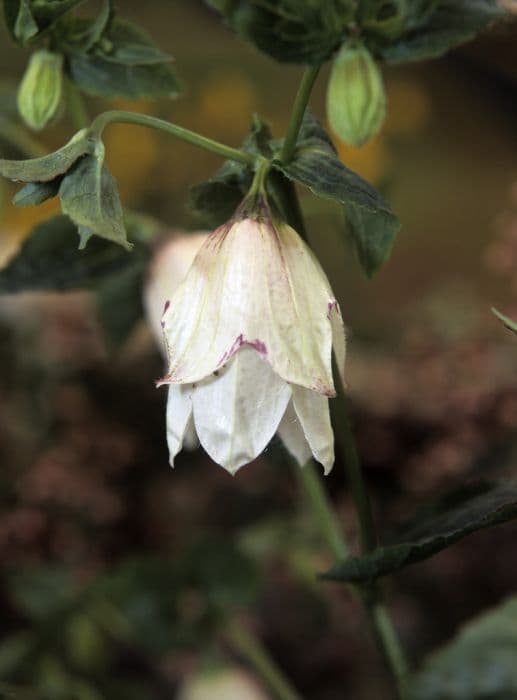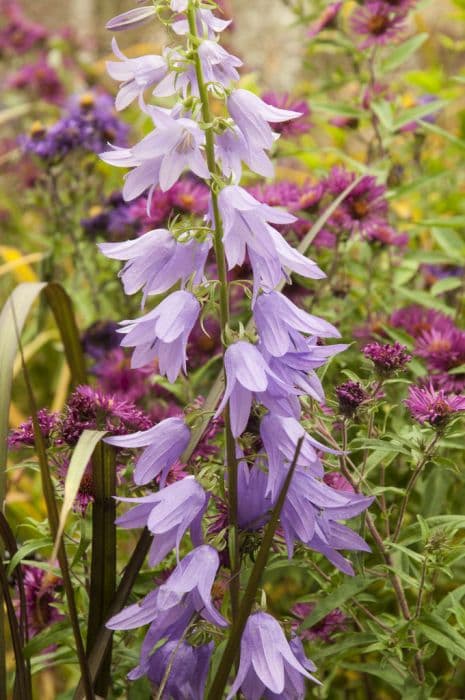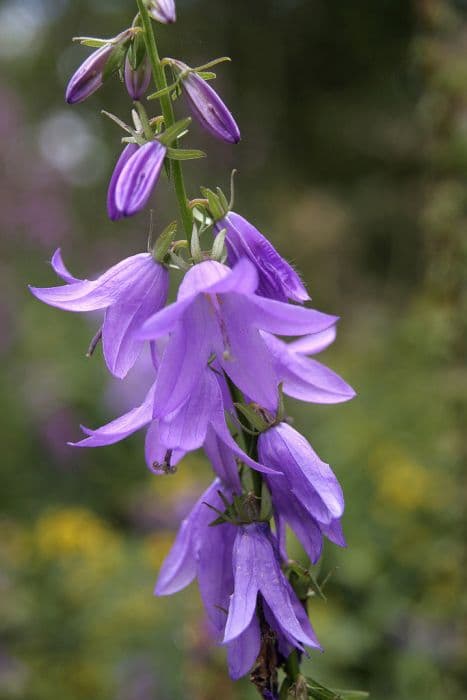Spotted Bellflower Campanula punctata 'Wedding Bells'

ABOUT
The plant known as Wedding Bells is distinguished by its attractive bell-shaped flowers. The blossoms come in a soft pink hue, which can sometimes appear with white highlights, adding to its romantic and delicate appearance. The blooms are sizable and hang gracefully from the stems, resembling little bells, which can often be spotted swaying in a light breeze. The leaves of Wedding Bells are a bright green color and have a heart-shaped to oval form, providing a verdant backdrop for the eye-catching flowers. The foliage may also have a slightly textured or toothed edge, contributing to the overall lush and tactile quality of the plant. This plant's flowers and leaves come together to create a display that is both charming and elegant, making it a favored choice for gardeners looking to add a touch of whimsy to their floral arrangements or garden beds. The name Wedding Bells particularly evokes the feeling of a romantic, fairy-tale garden setting.
About this plant
 Names
NamesSynonyms
Spotted Bellflower, Cherry Bells, Purple Bellflower, Dotted Bellflower
Common names
Campanula punctata 'Wedding Bells'.
 Toxicity
ToxicityTo humans
Spotted bellflower is not widely known for being toxic to humans. There are no significant reports of toxicity or poisoning from ingestion of this plant. However, like with any plant material, individual allergic reactions or sensitivities can occur, so it is generally advised that one does not eat or handle plants not known to be edible without proper knowledge.
To pets
Spotted bellflower is not commonly listed as a toxic plant to pets such as cats and dogs. No major toxicity is typically associated with this plant when pets are exposed to it. Nonetheless, ingestion of any plant material can potentially lead to gastrointestinal upset in pets, such as vomiting or diarrhea, especially if consumed in large quantities or if the animal has a specific sensitivity. It is always a good practice to keep an eye on your pet and consult with a veterinarian if unusual symptoms occur after ingestion of any plant matter.
 Characteristics
CharacteristicsLife cycle
Perennials
Foliage type
Deciduous
Color of leaves
Green
Flower color
Pink
Height
1-2 feet (30-60 cm)
Spread
1-2 feet (30-60 cm)
Plant type
Herb
Hardiness zones
3-8
Native area
East Asia
Benefits
 General Benefits
General Benefits- Ornamental value: Campanula punctata 'Wedding Bells' offers aesthetic appeal with its bell-shaped flowers, which can enhance the beauty of gardens and landscapes.
- Low maintenance: This plant is relatively easy to care for, requiring minimal maintenance, making it suitable for gardeners of all skill levels.
- Attracts pollinators: The flowers of the plant attract bees, butterflies, and other pollinating insects, supporting biodiversity.
- Drought tolerance: Once established, it has good drought tolerance, making it suitable for xeriscaping or gardens in drier climates.
- Long blooming period: With a long flowering season, it provides visual interest in the garden for an extended time.
- Versatility: It can be used in various garden settings, including borders, rock gardens, and as ground cover, due to its spreading habit.
- Rapid growth: This plant tends to grow quickly, filling in garden spaces and providing coverage where needed.
- Cold hardy: It is capable of surviving in cooler climates, making it a sturdy addition to a variety of garden zones.
- Propagation: It can be easily propagated by division, allowing gardeners to multiply their plants and share with others.
- Deer resistance: The plant is not a favorite with deer, which can help prevent damage in areas where deer browsing is a problem.
 Medical Properties
Medical PropertiesThis plant is not used for medical purposes.
 Air-purifying Qualities
Air-purifying QualitiesThis plant is not specifically known for air purifying qualities.
 Other Uses
Other Uses- Photography subject - The striking appearance of Campanula punctata 'Wedding Bells' with its large, bell-shaped flowers makes it a favorite among photographers, especially for macro photography.
- Floral art - Its unique shape and form can be used in floral arrangements and art installations to add an unconventional and visually interesting element.
- Educational tool - Botany teachers can use the plant to demonstrate the characteristics of the Campanulaceae family or bellflower family to students.
- Fairy gardens - The enchanting bells of Campanula punctata make them ideal for creating whimsical fairy garden displays.
- Tattoo inspiration - The delicate and ornate flowers can serve as inspiration for botanical-themed tattoos.
- Theme gardens - The 'Wedding Bells' variety can be utilized in wedding-themed gardens, where they contribute to the romantic ambiance with their symbolic nod to matrimony.
- Color palettes - Designers can draw inspiration from the plant's colors to create natural and soothing color schemes for interior or graphic design projects.
- Seed harvesting - Hobbyists might enjoy harvesting the seeds of Campanula punctata 'Wedding Bells' as a means to understand plant reproduction and to propagate new plants.
- Dye source - The pigments from the flowers could potentially be used for natural dyeing processes in crafts or textiles.
- Culinary decoration - The non-toxic flowers can be used as decorative elements for salads and other cold dishes, although it is not a common practice due to their size and texture.
Interesting Facts
 Feng Shui
Feng ShuiThe Spotted Bellflower is not used in Feng Shui practice.
 Zodiac Sign Compitability
Zodiac Sign CompitabilityThe Spotted Bellflower is not used in astrology practice.
 Plant Symbolism
Plant Symbolism- Everlasting Love: The bell-shaped flowers of the Campanula, commonly known as Bellflower, are reminiscent of a harmonious, long-lasting relationship, making them a symbol of enduring love.
- Gratitude: In the language of flowers, the Bellflower can represent a sense of gratitude, expressing appreciation for the kindness or support of others.
- Constancy: With its perennial nature and consistent flowering, the Bellflower symbolizes constancy and the idea of staying true over time.
- Affection: The soft, rounded blooms of the Campanula evoke feelings of affection and can signify warm, heartfelt emotions towards others.
- Viability: The robust nature of the Campanula, which allows it to flourish in a variety of settings, symbolizes viability and the ability to thrive in different environments.
 Water
WaterThe Spotted Bellflower should be watered regularly, aiming for moist but not waterlogged soil. During the active growing season in spring and summer, water thoroughly once a week with about 1 to 1.5 gallons, depending on the size of the plant and environmental conditions. Reduce the frequency of watering in the fall and winter months when the plant's growth slows down. Always check the top inch of the soil before watering; if it feels dry to the touch, it’s time to water. Ensure that the pot has good drainage to prevent root rot.
 Light
LightSpotted Bellflower thrives best in partial shade to full sun conditions. It is adaptable and can also perform well in bright, indirect light, making it suitable for a sunny window or a spot in the garden that receives morning light and afternoon shade. Avoiding the intense heat of the midday sun will help maintain vibrant blooms and prevent scorching of the leaves.
 Temperature
TemperatureSpotted Bellflower prefers moderate temperatures and can generally withstand minimum temperatures down to around 30°F. The ideal temperature range for this plant is between 60°F and 75°F. Protection from extreme cold is necessary, as temperatures below 30°F can damage or kill the plant, whereas it can tolerate temperatures up to about 85°F without issue.
 Pruning
PruningPrune the Spotted Bellflower to encourage bushier growth and more flowers. Deadhead spent blooms regularly to promote continuous flowering throughout the season. Perform a more thorough pruning in late winter or early spring, cutting the plant back by a third to stimulate new growth. Pruning is also an opportunity to shape the plant and maintain its size within the desired space.
 Cleaning
CleaningAs needed
 Soil
SoilSpotted Bellflower thrives in well-draining soil with rich organic matter. The best soil mix is equal parts garden soil, peat, and perlite or sand to ensure drainage. This plant prefers a soil pH of 6.0 to 7.5, slightly acidic to neutral.
 Repotting
RepottingSpotted Bellflower should be repotted every 2 to 3 years to replenish soil nutrients and to accommodate root growth. Spring is the ideal time for repotting to give the plant a fresh start for the growing season.
 Humidity & Misting
Humidity & MistingSpotted Bellflower prefers moderate humidity levels. Aim for a humidity around 50% for optimal growth. Avoid extremely high humidity to prevent issues with mold or rot.
 Suitable locations
Suitable locationsIndoor
Provide bright indirect light and regular watering.
Outdoor
Plant in partial shade and provide regular watering.
Hardiness zone
3-9 USDA.
 Life cycle
Life cycleThe Spotted Bellflower 'Wedding Bells' begins its life cycle as a seed, which, when sown in fertile, well-draining soil and exposed to the right environmental conditions, germinates to produce a seedling. As it grows, the seedling develops into a vegetative plant with a rosette of basal leaves and elongated stems, during which it may also form a tight clump of growth through vegetative propagation. As it reaches maturity, the plant produces tall flower spikes adorned with pendant, bell-shaped flowers that range in color from pink to purple and are characterized by spotting within the bells. After the flowering period, which typically occurs in late spring to early summer, the plant sets seed which can be dispersed by wind or animal activity. Throughout its life, the Spotted Bellflower 'Wedding Bells' may undergo periods of dormancy, especially in colder climates where it dies back to the ground in winter, only to resurge from its hardy root system with the arrival of warmer spring temperatures. The plant can live for several years, continuing its cycle of growth, flowering, and dormancy as a perennial.
 Propogation
PropogationPropogation time
Spring-Early Summer
The most popular method of propagation for the Campanula punctata 'Wedding Bells', commonly known as Spotted Bellflower, is division, which is best performed in the spring. To propagate by division, gently lift the plant from the ground using a garden fork, carefully separating the plant into smaller clumps while ensuring each new piece has a portion of the root system. After division, the clumps should be immediately replanted into a well-prepared soil bed or container, spaced about 12 inches (approximately 30 centimeters) apart to allow for growth. The newly planted divisions should be watered thoroughly to help establish their roots in the new location. This simple method allows gardeners to quickly increase their stock of Spotted Bellflowers and ensure healthy, blooming plants in the following season.








